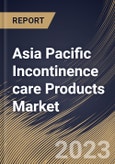Many individuals prefer to manage their incontinence at home, either independently or with the assistance of family caregivers. The availability of incontinence care products in retail stores and online markets makes it convenient for individuals to access the products they need. Athletes and individuals with active lifestyles also use specialized incontinence care products for sports and physical activities. These products offer discreet and effective protection, allowing individuals to pursue their passions without concern.
Moreover, with the regional population aging at an unprecedented rate, the prevalence of incontinence has increased significantly. Consequently, the demand for incontinence care products has surged, particularly in regions with a high proportion of elderly individuals. Increased awareness about incontinence and its management options has encouraged individuals to seek help and adopt suitable products.
Educational campaigns, healthcare professionals' guidance, and public awareness initiatives have played a crucial role in reducing the stigma associated with incontinence. The incontinence care products market has witnessed significant technological advancements, developing more effective, comfortable, and discreet products. Innovations like moisture-wicking materials, Odor control, and wearable technology have improved user experiences.
China is experiencing a significant increase in its aging population, primarily due to improved healthcare, better living conditions, and increasing life expectancy. Life expectancy in China has been on the rise for several decades. This increase is attributed to advancements in healthcare, nutrition, and living standards. China's demographic structure is shifting, with a larger proportion of the population falling into the older age groups (typically defined as 60 years and above). This shift is a result of the one-child policy and increasing longevity. Rapid urbanization in China has led to changes in lifestyle and healthcare access. Urban areas have better healthcare services and living conditions, contributing to longer life spans. All these factors will propel the growth of the incontinence care products market in the region.
The China market dominated the Asia Pacific Incontinence Care Products Market by Country in 2022, and would continue to be a dominant market till 2030; thereby, achieving a market value of $1,459.7 million by 2030. The Japan market is registering a CAGR of 6% during (2023 - 2030). Additionally, The India market would showcase a CAGR of 7.3% during (2023 - 2030).
Based on Usage, the market is segmented into Disposable, and Reusable. Based on Gender, the market is segmented into Female, and Male. Based on Distribution Channel, the market is segmented into Retail Pharmacies, Hospital Pharmacies, and Online Pharmacies. Based on End-use, the market is segmented into Home-patients, Hospitals & ASC's, and Others. Based on Product Type, the market is segmented into Absorbents (Pads & Guards, Underwear & Briefs, Bed Protectors, and Others), and Non-absorbents (Catheters, Drainage Bags, Stimulation Devices, and Others). Based on countries, the market is segmented into China, Japan, India, South Korea, Singapore, Malaysia, and Rest of Asia Pacific.
The market research report covers the analysis of key stake holders of the market. Key companies profiled in the report include Essity AB, The procter & Gamble Company, Kimberly-Clark Corporation, Hartmann Group (Paul Hartmann AG), Ontex BV, Domtar, Inc., ConvaTec Group Plc, Hollister, Inc., Coloplast Group, Wellspect Healthcare AB
Scope of the Study
Market Segments Covered in the Report:
By Usage (Volume, Million Units, USD Million, 2019-2030)- Disposable
- Reusable
- Female
- Male
- Retail Pharmacies
- Hospital Pharmacies
- Online Pharmacies
- Home-patients
- Hospitals & ASC's
- Others
- Absorbents
- Pads & Guards
- Underwear & Briefs
- Bed Protectors
- Others
- Non-absorbents
- Catheters
- Drainage Bags
- Stimulation Devices
- Others
- China
- Japan
- India
- South Korea
- Singapore
- Malaysia
- Rest of Asia Pacific
Key Market Players
List of Companies Profiled in the Report:
- Essity AB
- The procter & Gamble Company
- Kimberly-Clark Corporation
- Hartmann Group (Paul Hartmann AG)
- Ontex BV
- Domtar, Inc.
- ConvaTec Group Plc
- Hollister, Inc.
- Coloplast Group
- Wellspect Healthcare AB)
Unique Offerings
- Exhaustive coverage
- The highest number of Market tables and figures
- Subscription-based model available
- Guaranteed best price
- Assured post sales research support with 10% customization free
Table of Contents
Companies Mentioned
- Essity AB
- The procter & Gamble Company
- Kimberly-Clark Corporation
- Hartmann Group (Paul Hartmann AG)
- Ontex BV
- Domtar, Inc.
- ConvaTec Group Plc
- Hollister, Inc.
- Coloplast Group
- Wellspect Healthcare AB
Methodology

LOADING...








